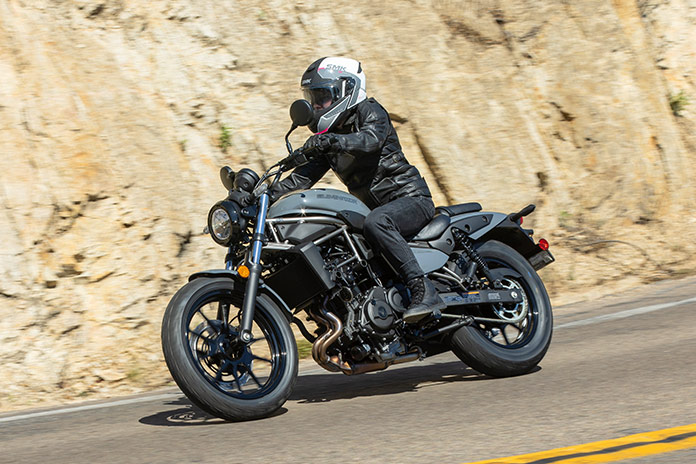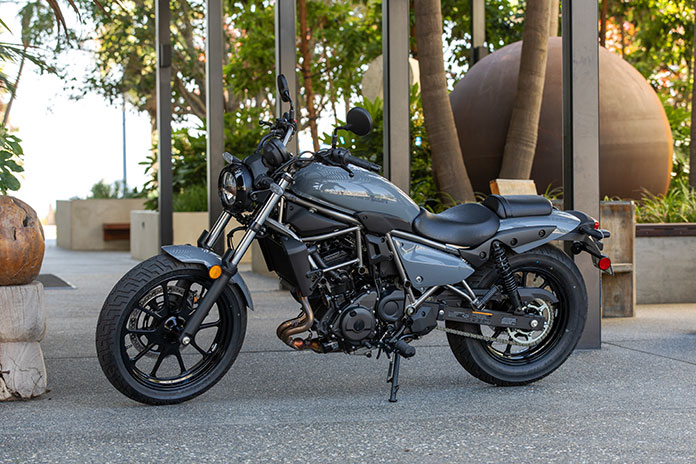
When a new rider asks for advice on a good first bike, they quickly find out that opinions vary wildly. Some will suggest a bike in the 250-300cc range, but that might not be ideal for riders who frequently travel at highway speeds. Others will suggest larger-displacement bikes that the new rider won’t outgrow, but those might be too intimidating and squash what little confidence the new rider had to begin with.
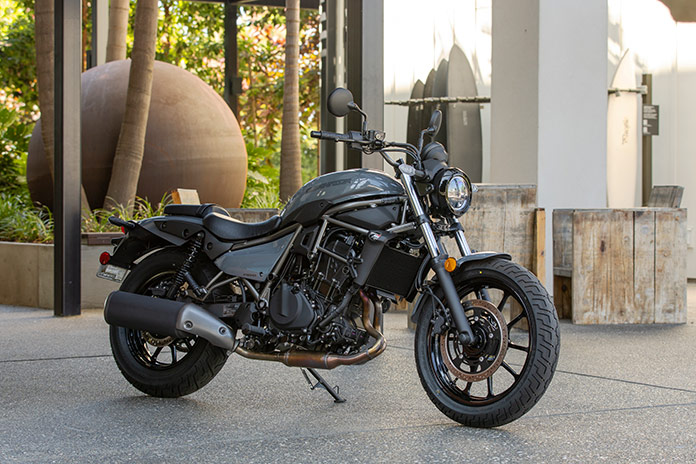
The 2024 Kawasaki Eliminator seeks to be the Goldilocks in this story, slotting above the smaller-displacement beginner bikes to be the bowl of porridge that is just right: It’s an approachable machine that will grow with a new rider while providing enough punch to entertain an intermediate rider.
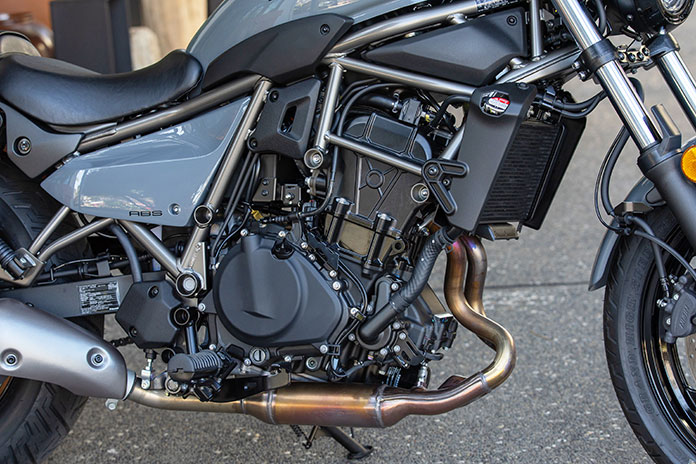
Related: Kawasaki Ninja 400 ABS | First Ride Review
The Eliminator also seeks to attract new riders with a sport-cruiser style. The new 451cc parallel-Twin derived from the Ninja 400 likes to rev high and provides pizzazz, and the new chassis and ergonomics fall somewhere between a cruiser and a standard, making for a controllable yet comfortable riding experience. Add to that a light curb weight of only 386 lb for the base model, and you get a motorcycle that’s both easy and exciting to ride.
While the 2024 Eliminator is an all-new model for Kawasaki, the name is a familiar one. It first appeared in 1985 with the ZL900 Eliminator, a cruiser stuffed with the ZX900 Ninja’s liquid-cooled inline-Four. The Eliminator name carried on to other models up into the mid-2000s. Now, the Eliminator has returned and brings some of the sport-influenced lineage with it.
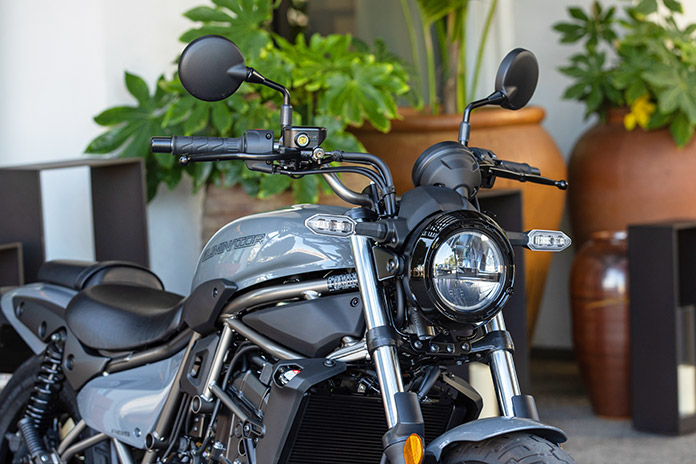
The Eliminator makes some nods to its namesakes in the styling department. The round headlight harkens back to earlier days, although now all lighting is LED. The tailsection is also reminiscent of older models, as are the headlight cowl and fork boots available on the SE version of the Eliminator.
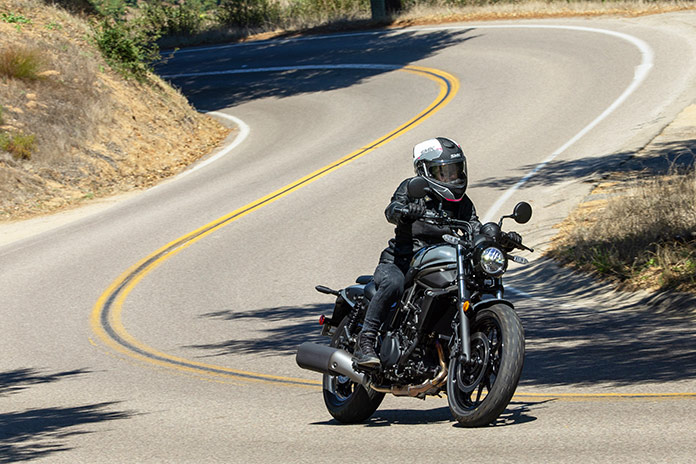
These styling hints are incorporated into a contemporary look, so nobody will think you’re riding around on your dad or mom’s old bike recently unburied from the back of the garage. With a mostly blacked-out frame and other components, a slim fuel tank, and a tidy taillight and turnsignals, this is a modern-looking machine.
Kawasaki did a good job of making the Eliminator feel like a “real” cruiser – although the same can’t be said for its sound. The parallel-Twin uses a 180-degree crankshaft instead of the more popular and rumbly 270, so it doesn’t have a deep exhaust note befitting a cruiser. Some are more interested in how a bike performs, but there’s something to be said – particularly for cruisers – for sound and style. Deep down, we love a bike with character, and whereas Kawasaki has paid attention to the character of the Eliminator’s style, the company has missed the mark on giving us those nice rumbling exhaust notes we expect from a cruiser.
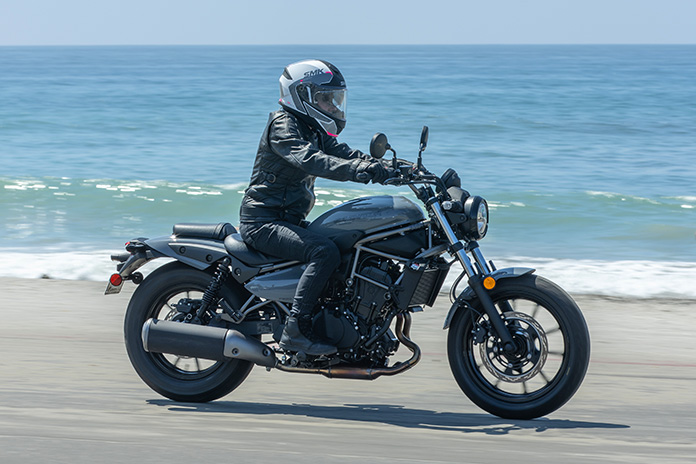
GEAR UP
- Helmet: SMK Gullwing Modular
- Jacket: Highway 21 Women’s Pearl
- Gloves: Highway 21 Women’s Black Ivy
- Pants: Alpinestars Daisy V2 Women’s Riding Denim
- Boots: Highway 21 Axle Waterproof Shoes
The good thing is that once you start riding, you remember that exhaust notes are superficial, and the real spirit of a motorcycle lies in its performance. What the engine lacks in sound, it makes up for in the riding experience. The liquid-cooled 451cc parallel-Twin with DOHC is derived from the Ninja 400’s 399cc platform, and its extra displacement comes from lengthening the stroke by 6.8mm, from 51.8mm to 58.6. That longer stroke adds torque befitting a cruiser, and that extra grunt is obvious while riding. This is a bike that is happy to lope through town and sit comfortably in a cruiser rev range with nice low-end pull. That is, until you decide to twist that throttle for a little more pep.

Upon that twist, you’ll discover that this engine has so many revs to give. Redline shows at 11,000 rpm on the tachometer, and the power keeps building until that limit. Where you’d expect a cruiser like this to need shifting much earlier, this engine is eager to rev. Although Kawasaki doesn’t slot the Eliminator into the “sport-cruiser” category, the engine’s attitude certainly does. It pulls down low for a satisfying power surge, and then it continues building power all the way to its rev limit.
Engine performance is only a small part of the equation for a fun and comfortable beginner to intermediate bike. We need ergonomics to match. The riding position of the Eliminator is sportier than most cruisers. The mid-mount footpegs give a sense of control that is often lacking on more forward-mounted cruiser pegs. The 28.9-inch seat height is also a little taller than many cruisers. At five-foot-one, I am not able to flat-foot on the Eliminator, but I feel stable enough that I would be comfortable on this bike as a new rider. Accessory seats that raise or lower the height by 1 inch are available. The stock seat is nice and plush with a slightly scooped-out design.
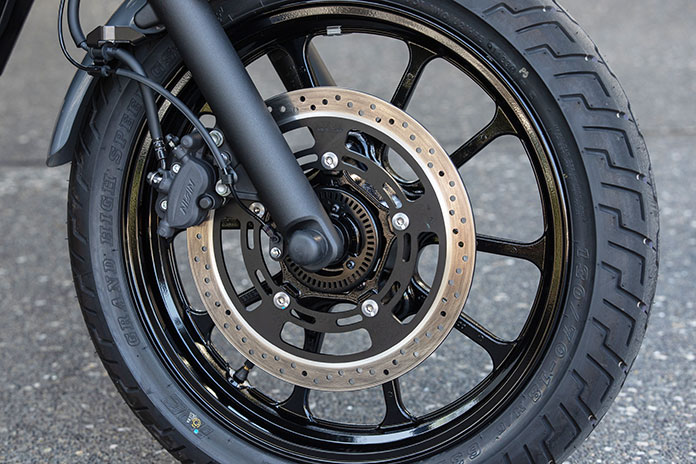
The Eliminator’s brakes are uninspiring but get the job done. Up front is a single 310mm disc with a twin-piston caliper, and in the back is a single 220mm disc with a single-piston caliper. The ABS version of the Eliminator adds $300 onto the base price and 2 lb to the wet weight. The 41mm telescopic fork has 4.7 inches of travel, and the twin shocks have 3.1 inches of travel, and there is no adjustability. The suspension felt well balanced and absorbed all but the most egregious road bumps.
The round instrumentation screen also harkens back to Eliminators of yore. The LCD screen has a tachometer up top, speedometer, gear indicator, clock, fuel level, and the option to switch between odometer, two tripmeters, fuel range, and current and average fuel consumption.
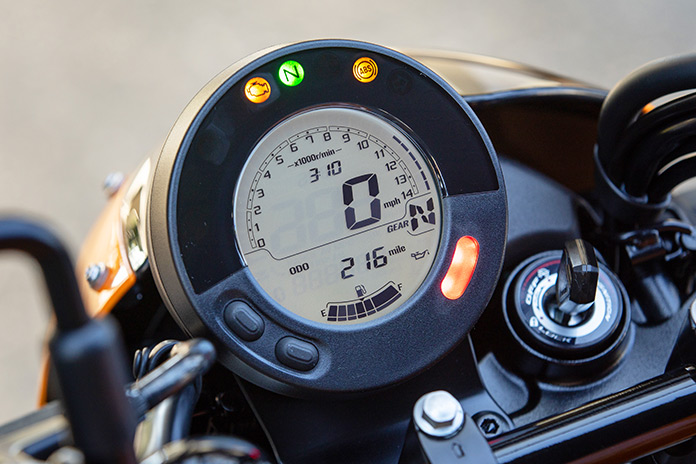
The Eliminator pairs with Kawasaki’s Rideology app. Once connected, the display will show message and call information. More interesting are the options available on the app itself, which includes vehicle information and general display settings (such as preferred units and clock format).
Most interesting is Rideology’s ability to log your rides. I used the app to track our test ride in and around Oceanside, California, and it showed a map of the route and information such as date and time, location, mileage, total trip time, and average speed. I found this feature quite fun, and I enjoyed the ability to look back at my route after the ride had ended. The app stops tracking the ride if the bike is keyed off, but as long as the rider remembers to resume the route on the app after gas or lunch stops, that isn’t an issue.
Other useful technologies on the Eliminator are the slip/assist clutch and the positive neutral finder. The slip/assist clutch results in a very light clutch pull and easy shifting, which was helpful for reducing fatigue during our several photo stops throughout the test ride day. The positive neutral finder is a feature that is quite helpful for newer riders. When stopped or traveling below 6 mph, a lift of a toe from first gear will automatically access the neutral position and prevent upshifting to 2nd gear.
Related: 2023 Kawasaki Ninja ZX-4RR | First Ride Review
The Eliminator’s closest competitor is the Honda Rebel 500, which has a starting price of $6,449 for model year 2023. Both bikes have a sporty cruiser style, and a glance at the spec charts shows similar numbers. The Honda Rebel has 20cc more displacement than the Eliminator, but they make roughly the same torque (about 32 lb-ft). Kawasaki has not released horsepower figures for the Eliminator, but we expect those numbers to be similar as well. The Eliminator is lighter than the Rebel by 26 lb for the ABS versions, and the Eliminator has a longer wheelbase by about an inch. There are other small differences, but they stack up closely.
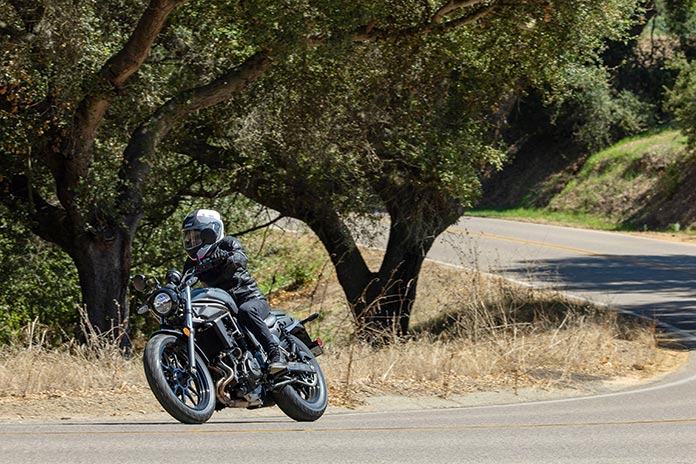
The Eliminator comes in three versions. The base model has an MSRP of $6,649. For an extra $300, you can upgrade to the ABS version. Both the base model and ABS version are available in Pearl Robotic White and Pearl Storm Gray. Tack on another $300, and for $7,249, you’ll get the SE version, which includes ABS, a headlight cowl, a USB-C outlet, fork boots, and a two-pattern seat. It’s also the only version available in the eye-catching Candy Steel Furnace Orange/Ebony colorway.
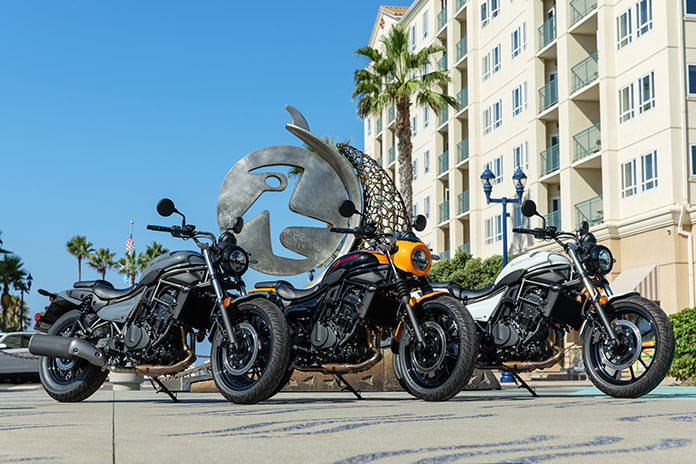
As someone who loves to see new riders finding their place in the world of motorcycling, I’m glad Kawasaki has recognized a hole in its lineup and made the effort to fill it, providing a cruiser option that’s more approachable and significantly lighter than the 650cc Vulcan S. With its light weight, low seat height, comfortable riding position, and a Ninja-derived engine, the Eliminator is a motorcycle that is as welcoming as it is fun.
Check out more new bikes in Rider‘s 2024 Motorcycle Buyers Guide
2024 Kawasaki Eliminator Specifications
- Base Price: $6,649
- Price as Tested: $6,949 (w/ ABS)
- Website: Kawasaki.com
- Warranty: 1 yr., unltd. miles
- Engine Type: Liquid-cooled, parallel-Twin, DOHC w/ 4 valves per cyl.
- Displacement: 451cc
- Bore x Stroke: 70.0 x 58.6mm
- Torque: 31.7 lb-ft (factory claim)
- Transmission: 6-speed, cable-actuated slip/assist wet clutch
- Final Drive: Chain
- Wheelbase: 59.8 in.
- Rake/Trail: 30 degrees/4.8 in.
- Seat Height: 28.9 in.
- Wet Weight: 386 lb (388 lb w/ ABS)
- Fuel Capacity: 3.4 gal.
See all of Rider‘s Kawasaki coverage here.
The post 2024 Kawasaki Eliminator Review | First Ride appeared first on Rider Magazine.
Source: RiderMagazine.com

